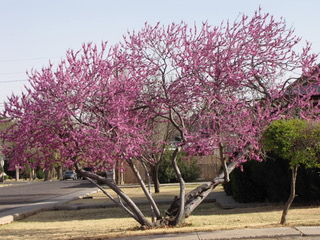by Sabina Muñoz, El Paso Master Gardener

Credit: Red Bud in Bloom by Gail Hedrick, El Paso Master Gardener
Choosing a landscape tree is one of the most important decisions a home owner must make. Most trees have the potential of outliving the people who plant them, so the decision deserves some research and forethought.
What is the tree going to do? Will it provide shade, be a windbreak, screen an unpleasant view, provide fruit or nuts, provide seasonal color or ornamental blooms? Do you want an evergreen or a tree that sheds its leaves? Trees come in many shapes and sizes. They can be round, fan-shaped, conical, single-trunked and multi-trunked. Some can grow so big that they are disproportionate to home and neighborhood. Imagine what that cute tree in a nursery container will look like in a few years. The space you have should be large enough to support the mature tree without damaging walks and drives or interfering with utility and power lines above or below ground.
Your site should have the right kind of soil for the tree you choose. El Paso soils are alkaline, and some trees require more acidic soils. Is your soil sandy, clay or loamy? The type of soil will determine how you must water your plants. Knowing your soil type will help you choose a tree that will thrive in that location.
Some trees are high maintenance and require pruning, raking of litter and seedpods, and regular fertilization. Your tree’s water needs should be compatible with nearby landscape elements such as grass, shrubs and flowers. A high water-use tree should not be placed in your cactus garden. The tree should handle our climate’s hot summers and sometimes very cold winters.
It is helpful to visit established neighborhoods and see mature trees in place. You can better visualize how your tree will look when it matures and get some ideas on how the trees perform in different locations.
If you do your homework and plan accordingly, you’ll have a long and happy relationship with the right tree in the right place in your landscape.